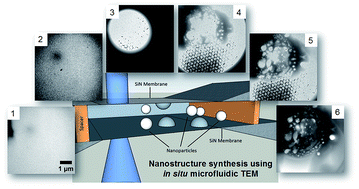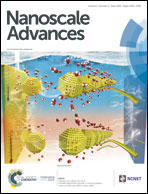Synthesis of complex rare earth nanostructures using in situ liquid cell transmission electron microscopy†
Abstract
Energy and cost efficient synthesis pathways are important for the production, processing, and recycling of rare earth metals necessary for a range of advanced energy and environmental applications. In this work, we present results of successful in situ liquid cell transmission electron microscopy production and imaging of rare earth element nanostructure synthesis, from aqueous salt solutions, via radiolysis due to exposure to a 200 keV electron beam. Nucleation, growth, and crystallization processes for nanostructures formed in yttrium(III) nitrate hydrate (Y(NO3)3·4H2O), europium(III) chloride hydrate (EuCl3·6H2O), and lanthanum(III) chloride hydrate (LaCl3·7H2O) solutions are discussed. In situ electron diffraction analysis in a closed microfluidic configuration indicated that rare earth metal, salt, and metal oxide structures were synthesized. Real-time imaging of nanostructure formation was compared in closed cell and flow cell configurations. Notably, this work also includes the first known collection of automated crystal orientation mapping data through liquid using a microfluidic transmission electron microscope stage, which permits the deconvolution of amorphous and crystalline features (orientation and interfaces) inside the resulting nanostructures.



 Please wait while we load your content...
Please wait while we load your content...